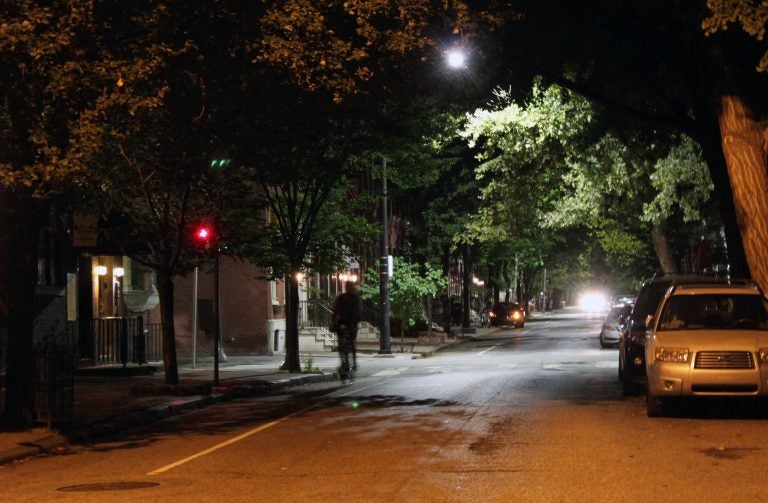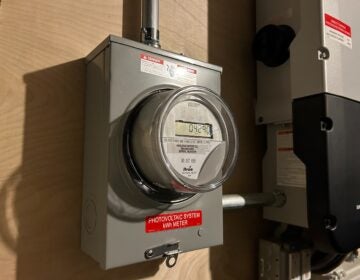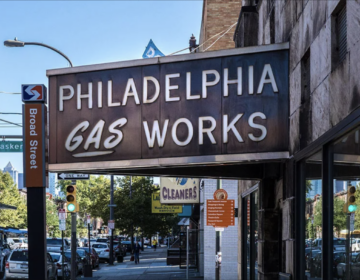Philly just took a step toward getting LED streetlights citywide
Local officials are seeking contractors to help replace the city’s 105,000 street lights with more energy-efficient LEDs.

LED lighting in the background vs high-pressure sodium lighting in the foreground on Spruce Street. (Office of Sustainability/Dominic McGraw)
At some point in the near future, the streets of Philadelphia will look whiter at night. The warm yellow glow provided by the city’s 105,000 streetlights will become a thing of the past, as the city replaces traditional high-pressure sodium bulbs to LEDs, which have a whitish glare.
That vision took a step forward this week when the City and Philadelphia Energy Authority put out a call for qualifications from contractors interested in helping LED-ify the city.
Light-emitting diode lights, or LEDs, emit more light-per-watt consumed than other kinds of bulbs. Typically, they are six to seven times more efficient than traditional incandescent bulbs and can last anywhere from three to 25 times longer.
By making the switch to LED, the city hopes to make progress on its Municipal Energy Master Plan, which aims to reduce Philadelphia’s energy consumption, lower its carbon emissions and expand the use of renewables.
“This is the largest energy-saving project that the city can undertake,” said Christine Knapp, director of the city’s Office of Sustainability.
Local officials are betting on the high-performing bulbs to help reduce city spending on energy for street lamps, another goal of the master plan. The city spends $12.9 million per year to keep its current network on. The proposals, received through the public bidding process begun this week, will help the city determine exactly how much money could ultimately be saved by going LED.
“The cost-saving potential is hard to calculate without having more firm proposals,” Knapp said. “We believe the cost savings would go towards paying down the upfront costs, so it should cost neutral at a minimum, but it’s hard to calculate beyond that,” Knapp said.
According to the U.S. Department of Energy, the widespread use of LEDs, compared to no LED use, could save the “equivalent annual electrical output of 44 large electric power plants” by 2027 and “more than $30 billion at today’s electricity prices.”
At the residential level, households could save $75 a year by replacing five of their most frequently used lights with LEDs.
The city has been replacing street lights to LEDs since 2015. Today there’s about 5,000 of them in different neighborhoods. Changing the remaining 100,000 could reduce municipal carbon emissions by 13,700 metric tons of CO2 equivalent, according to the Office of Sustainability.
“Those street lights take energy to operate. The electricity that powers those come from a variety of different sources, but a lot of the sources in Pennsylvania are coal and natural gas, which are fossil fuels that create carbon emissions,” Knapp explained.
Philadelphia energy officials are seeking contractors that can customize street lighting so it could vary from neighborhood to neighborhood and through different times of the day.
“A commercial corridor could be lit up brighter for longer hours or a residential area could have lights taper back in brightness overnight,” Knapp said. “It’s a kind of customization for neighborhoods that we don’t currently have.”
Brighter streets, safer streets
Brighter lights also mean safer streets for pedestrians, bikers and cars, officials say. LEDs emit a whiter glare than their predecessors, which can improve visibility. Some cities, like Los Angeles, say nighttime crime data for burglary and theft went down by 10% after the switch. The lights also improve face and color recognition on security cameras.
“Data from other cities shows that converting our streetlights to LED will have a significant impact on gun violence, public safety and quality of life in neighborhoods citywide,” said Council President Darrell Clarke in a press release.
But some, based on a 2016 study by the American Medical Association, argue high-intensity LED lights can have an impact on the health of humans, animals, birds and inspects. Members of BioPhilly, a local organization of architects and designers say 4000 Kelvin LED lights can emit a large enough amount of blue light to have harmful effects to people and wildlife.
Keith Russell, program manager of urban conservation for Audubon PA, said he has asked city officials working on the project to consider bird migrations. Intense beams of lights coming from buildings or roads could disorient tens of millions of birds that migrate through Philadelphia every year using the stars to detect the earth’s magnetic field, he said.
That problem is one city officials hope to address through customizing the network to meet location-specific needs. “If there are bird migration pathways that we know are important to adjust lightning around, we would be able to have more customization to do that,” Knapp said.
The Department of Energy, academics, and lighting professional and manufacturers’ associations have argued that there is a lack of evidence showing negative effects on LED street lighting.
Knapp said the city will take into consideration AMA’s guidance, the experiences of other cities and input from city residents gathered at public meetings.
“My reading of a lot of guidance thus far hasn’t said: don’t do LED, LED are bad. It just basically says there’s good ways and bad ways to do it, as with anything, so there’s impacts you need to think about and be sensitive to — which we are aware of and we will be incorporating,” Knapp said.
The streetlight conversion is one of a series of steps the city has been working on to reach its climate goals. According to an update on its municipal energy plan published this week, the city has reduced its carbon pollution by 33 percent since 2006. Mayor Jim Kenney’s goal is to lower it to 50 percent by 2030.
Buildings and the city’s built environment are responsible for 80% of Philly’s carbon emissions. The city’s goal for 2030 is to reduce current emissions from 148,000 to 109,700 metric tons of CO2 equivalent.
The city has not yet identified funding mechanisms for the citywide LED switchover. There’s no implementation date either.
The request for qualifications, due in March, will be followed by a request for proposals. So there’s still some time to walk down a Philadelphia street at night under that old sepia light.
WHYY is your source for fact-based, in-depth journalism and information. As a nonprofit organization, we rely on financial support from readers like you. Please give today.







